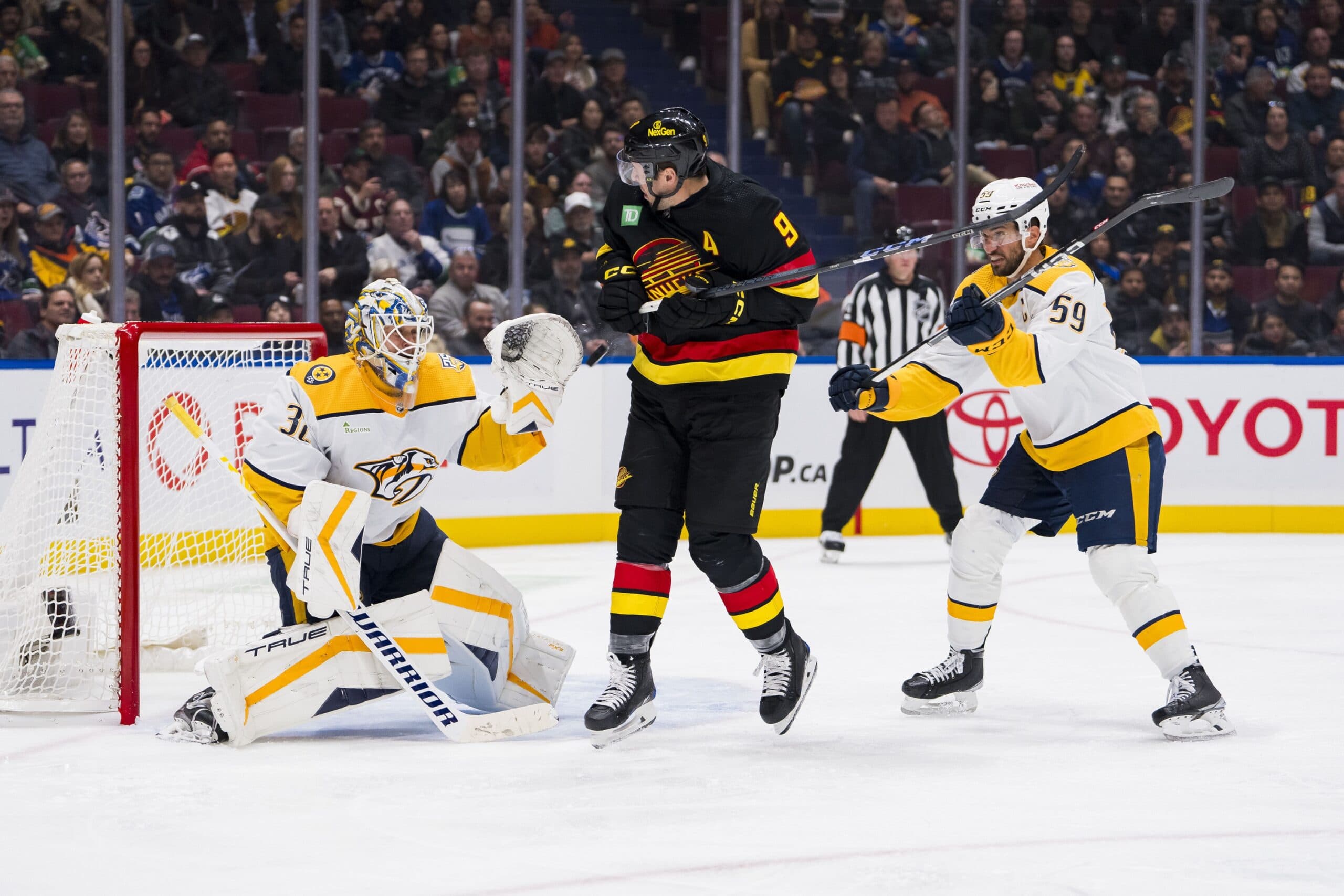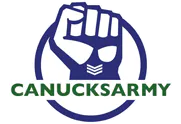Nation Sites
The Nation Network
CanucksArmy has no direct affiliation to the Vancouver Canucks, Canucks Sports & Entertainment, NHL, or NHLPA
Canucks can still sail under the salary cap after signing Kevin Lankinen

Photo credit: © Bob Frid-Imagn Images
Sep 23, 2024, 10:00 EDTUpdated: Sep 23, 2024, 01:18 EDT
They say good things come to those who wait, and that notion seems to hold truer for Vancouver Canucks general manager Patrik Allvin than it does most people.
Last offseason, Allvin waited until mid-August to sign Pius Suter and, as a result, managed to get the centre under contract for two years at a $1.6 million AAV. That’s a deal that has already returned excellent value, and it’s still got a year left on it.
This year, it was Kevin Lankinen’s turn to play a one-on-one version of the waiting game. The result this time is a one-year, $875,000 contract that just so happens to be the exact amount the Canucks needed in order for Lankinen to cover Thatcher Demko’s injury without breaking the bank.
And we’re only barely using “breaking the bank” in the euphemistic sense. The Canucks have some very real financial constraints to work around this season, but more than that, they’ve got financial goals to work toward. One of them, as outlined by Allvin several times and elaborated upon in a recent CanucksArmy article, is to spend as much of the year as possible underneath the cap ceiling, thus allowing the Canucks to accrue cap space over time.
For more details on how accrual works, refer back to that aforementioned article. To find out how they’ll achieve it with Lankinen now in the fold, keep reading this one!
We should start by saying that nothing is concrete quite yet, because there’s still the bulk of a Training Camp and an entire exhibition schedule to get through, and that could naturally lead to some injuries occurring. Injuries complicate matters, and could change the picture in a hurry – primarily by resulting in the team needing to use LTIR relief space to call up temporary replacements, as described in that last article.
For now, we will stick with what we know for sure. That includes the pre-established knowledge that Tucker Poolman will not play hockey this season, the sad reality that Demko likely won’t be ready to start the regular season, and that there is also a possibility that the same is true for Dakota Joshua, who is recovering from surgery related to testicular cancer.
With that in mind, we’re going to lay out two scenarios, one in which Joshua is ready and on the ice for Game One of the regular season, and one in which he is not.
Scenario One: Dakota Joshua is ready for Game One
We should also start by making clear that what we’re describing here is our anticipated Canucks roster for Game One of the regular season, NOT their opening day roster, which is something officially submitted to the NHL. On that front, we expect a few paper-transactional shenanigans, primarily related to locking in Jonathan Lekkerimäki’s performance bonus cushion, but we’ll include a segment about that at the end and then spin that out into a whole ‘nother article.
For the meantime, we’re concerned with what the Canucks’ roster will actually look like by the time they face the Calgary Flames on October 9 – and, more importantly for the purposes of this article, what their cap books will look like at that time.
For Scenario One, in which Joshua returns to health in time to play in Game One of the regular season, the goal will be to start the season with Poolman and Demko on regular IR – as opposed to LTIR – and to stay under the cap while doing so.
With Lankinen now locked in at a bargain rate, it’s actually pretty easy to accomplish.
All told, the Canucks can fit an active roster of 13 healthy forwards (Elias Pettersson, JT Miller, Brock Boeser, Jake DeBrusk, Conor Garland, Dakota Joshua, Danton Heinen, Teddy Blueger, Pius Suter, Kiefer Sherwood, Nils Höglander, Daniel Sprong, Nils Åman), seven healthy defenders (Quinn Hughes, Filip Hronek, Carson Soucy, Tyler Myers, Vincent Desharnais, Derek Forbort, Noah Juulsen), and two healthy goaltenders (Lankinen, Arturs Silovs). Again, Poolman and Demko will be on the IR.
There may be some quibbling to be had about the bottom-end of those lists. Maybe, for example, Phil di Giuseppe makes it over Åman, for example, or maybe Jett Woo beats out Juulsen for the extra D spot. Either way, the cap numbers won’t change much, and this roster of 22 is going to be the max they can fit under the cap.
All told, this scenario adds up (once Oliver Ekman-Larsson’s buyout and Ilya Mikheyev’s retention are factored in) to a cap hit of $87,909,167, which is just $90,833 under the cap.
To illustrate what this would actually look like, we’ve employed our friends over at Puckpedia’s PuckGM mode to chart our various scenarios:


From PuckPedia
That doesn’t leave much space for accrual (it adds up to less than $1,000,000 by the Trade Deadline), or for any call-ups to cover any further injury. But it is an amount that will grow slowly over time, and it does give the Canucks options.
When Demko returns, the Canucks would have the option of sending down one of Lankinen or Silovs and adding their subtracted salary to the daily accrual amount. Alternatively, they could swap the extra goalie out for a skater call-up, increasing the active roster size.
The Canucks would also have the option of starting out with an even smaller active roster, for the purposes of accruing more cap. They could, for example, drop whichever of Åman or Di Giuseppe or whoever claims the extra forward spot and roll without an extra forward at all for a time, thus adding more to their daily-counted accrual amount.
As in any case, further injuries will complicate this picture, and using LTIR relief space – as easy as popping Poolman on LTIR and gaining $2.5 million in extra spending room, at the cost of temporarily suspending daily accrual – might become inevitable.
But, for the time being, everything works neatly enough.
Scenario Two: Dakota Joshua is NOT ready for Game One
Speaking of further injuries complicating things, what happens if Joshua also needs to start out the regular season on regular IR?
In that scenario, the Canucks can still start the season under the cap and without using LTIR relief space, but it does become more difficult.
In short, the Canucks would need to start their season with a shorter active roster of just 21 heathy players, meaning only one extra skater – most likely on the back-end.
Take that same list of players we outlined above, and move Joshua from the forward group to the IR. You get 12 healthy forwards (Pettersson, Miller, Boeser, DeBrusk, Garland, Heinen, Blueger, Suter, Sherwood, Höglander, Sprong, Åman), seven defenders (Hughes, Hronek, Soucy, Myers, Desharnais, Forbort, Juulsen), and two goalies (Lankinen, Silovs). Now, it’s all three of Poolman, Demko, and Joshua on IR.
In financial terms, it leaves the Canucks in the exact same spot we had them in the previous scenario. On IR, Joshua’s full cap hit still applies, so the only difference here is an active roster that is one player shorter. Under this scenario, the Canucks are still $90,833 under the cap, just with an active roster of 21 now instead of 22.
This scenario further limits the Canucks options. They could still, for example, send down the one extra player (Juulsen, in this case) to bring the active roster down to 20 players and thus accrue extra cap space. But that would probably be deemed an unnecessary risk. Instead, the team would probably wait until either Joshua or Demko returned to the lineup to make adjustments.
Again, any further injury here almost certainly results in the Canucks temporarily using LTIR relief space to call-up replacements. But the good news is that, as we’ve previously uncovered, teams are able to temporarily go above the cap ceiling and then dip back down under it to start accruing cap again.
In other words, Joshua being out to start the year doesn’t end the Canucks dreams of sailing under the salary cap and accruing enough cap to use at the deadline – it just makes it a little harder to accomplish.
Bonus Performance Shenanigans: The Arturs Silovs Shuffle
We wrote an article previously about the issue of Jonathan Lekkerimäki’s performance bonuses, and the desire to get him on the opening day roster to lock in what they call a “performance bonus relief pool,” but is better described as a “performance bonus cushion.”
Read that article for the full explanation.
We still believe that will happen, and now that Lankinen is signed, it’s actually a pretty simple undertaking.
The short version is that the Canucks will leave Demko on their opening day active roster despite his still being injured, and will use Silovs’ waiver-exempt status to ‘paper’ him down to Abbotsford. Lekkerimäki will take his spot on the opening day roster, but before Game One is played, they’ll be swapped and Demko will hit the IR.
For the long version, you’ll have to read our next article, which we’re going to start writing…now.
Sponsored by bet365
Breaking News
- Canucks fall to dead last in NHL standings
- Canucks trade rumours: Flyers said no to a trade involving Owen Tippett
- Canucks: Quinn Hughes and Adam Foote address on-ice frustrations
- Scenes from practice: Höglander a full participant, Karlsson stays on Canucks’ top line
- Canucks injury updates: Höglander and Demko could return vs. Sabres next Thursday
